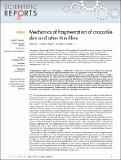| dc.contributor.author | Qin, Zhao | |
| dc.contributor.author | Pugno, Nicola M. | |
| dc.contributor.author | Buehler, Markus J. | |
| dc.date.accessioned | 2015-06-19T17:03:43Z | |
| dc.date.available | 2015-06-19T17:03:43Z | |
| dc.date.issued | 2014-05 | |
| dc.date.submitted | 2013-10 | |
| dc.identifier.issn | 2045-2322 | |
| dc.identifier.uri | http://hdl.handle.net/1721.1/97472 | |
| dc.description.abstract | Fragmentation of thin layers of materials is mediated by a network of cracks on its surface. It is commonly seen in dehydrated paintings or asphalt pavements and even in graphene or other two-dimensional materials, but is also observed in the characteristic polygonal pattern on a crocodile's head. Here, we build a simple mechanical model of a thin film and investigate the generation and development of fragmentation patterns as the material is exposed to various modes of deformation. We find that the characteristic size of fragmentation, defined by the mean diameter of polygons, is strictly governed by mechanical properties of the film material. Our result demonstrates that skin fragmentation on the head of crocodiles is dominated by that it features a small ratio between the fracture energy and Young's modulus, and the patterns agree well with experimental observations. Understanding this mechanics-driven process could be applied to improve the lifetime and reliability of thin film coatings by mimicking crocodile skin. | en_US |
| dc.description.sponsorship | National Science Foundation (U.S.) | en_US |
| dc.description.sponsorship | United States. Office of Naval Research | en_US |
| dc.description.sponsorship | United States. Air Force Office of Scientific Research | en_US |
| dc.language.iso | en_US | |
| dc.publisher | Nature Publishing Group | en_US |
| dc.relation.isversionof | http://dx.doi.org/10.1038/srep04966 | en_US |
| dc.rights | Creative Commons Attribution 3.0 Unported Licence | en_US |
| dc.rights.uri | http://creativecommons.org/licenses/by/3.0/ | en_US |
| dc.source | Nature | en_US |
| dc.title | Mechanics of fragmentation of crocodile skin and other thin films | en_US |
| dc.type | Article | en_US |
| dc.identifier.citation | Qin, Zhao, Nicola M. Pugno, and Markus J. Buehler. “Mechanics of Fragmentation of Crocodile Skin and Other Thin Films.” Sci. Rep. 4 (May 27, 2014). | en_US |
| dc.contributor.department | Massachusetts Institute of Technology. Center for Computational Engineering | en_US |
| dc.contributor.department | Massachusetts Institute of Technology. Department of Civil and Environmental Engineering | en_US |
| dc.contributor.department | Massachusetts Institute of Technology. Department of Materials Science and Engineering | en_US |
| dc.contributor.mitauthor | Qin, Zhao | en_US |
| dc.contributor.mitauthor | Buehler, Markus J. | en_US |
| dc.relation.journal | Scientific Reports | en_US |
| dc.eprint.version | Final published version | en_US |
| dc.type.uri | http://purl.org/eprint/type/JournalArticle | en_US |
| eprint.status | http://purl.org/eprint/status/PeerReviewed | en_US |
| dspace.orderedauthors | Qin, Zhao; Pugno, Nicola M.; Buehler, Markus J. | en_US |
| dc.identifier.orcid | https://orcid.org/0000-0002-4173-9659 | |
| mit.license | PUBLISHER_CC | en_US |
| mit.metadata.status | Complete | |
